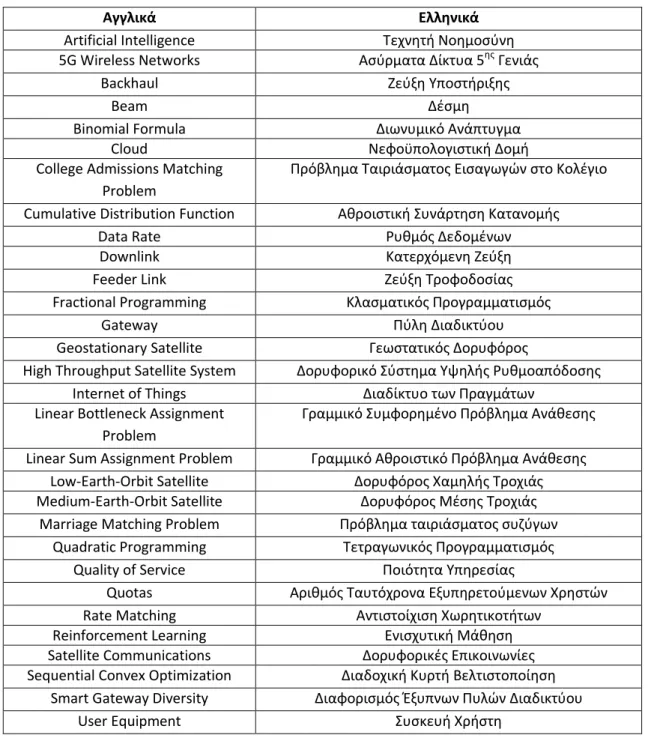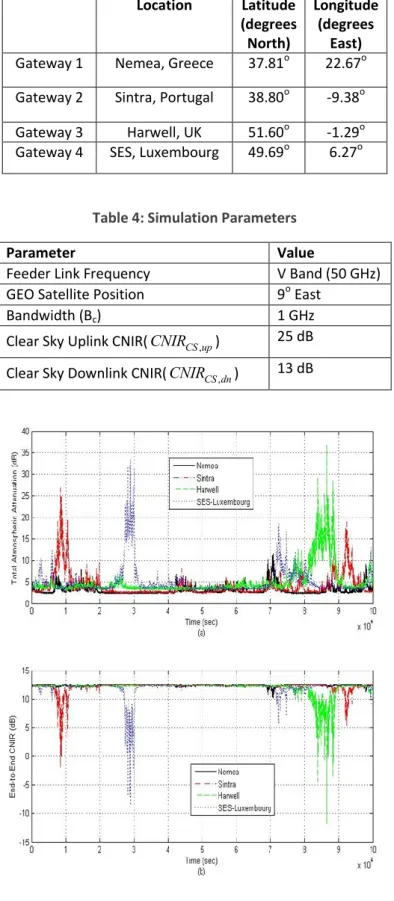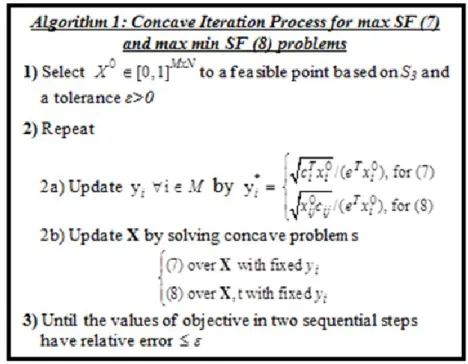Links between GWs and the satellite are called feeder links and use higher RF frequencies, such as Q/V or W bands. Lower frequencies, such as Ka band, are used for links between satellites and the UE beam, called user links (downlinks).

Extended Greek Summary-Εκτεταμζνη Περίληψη
Ειςαγωγι
Βζλτιςτεσ Μζκοδοι Σαιριάςματοσ Θεωρϊντασ τισ Ηεφξεισ Σροφοδοςίασ
Βζλτιςτεσ Μζκοδοι Σαιριάςματοσ Θεωρϊντασ τισ Κατερχόμενεσ Ηεφξεισ
Τποβζλτιςτεσ Μζκοδοι Σαιριάςματοσ για τθν Περίπτωςθ Ενόσ-προσ-Πολλά Ηεφγθ
Introduction
Current Status of Satellite Communications
In the case of uRLLC, the satellite can assist in broadcasting content, in the case of non-critical data and edge cache, i.e. In addition to the efforts for integration of satellite communications in 5G networks, there is a shift in the creation of high-performance optical networks. The study of optical satellite communication started by ESA in December 2016, under the ARTES program with the project name "SeCure and Laser Communication Technology (ScyLight)". The ScyLight project focuses European and Canadian industry efforts on optical communication technologies, specifically in the following areas: a) system-level optical communication technology, b) optical communication terminal technology, intra-satellite photonics and optical payloads and c) quantum cryptography technologies in space.
High Throughput Optical Network (Hydron) ", which aims to seamlessly integrate terrestrial and satellite infrastructure into a Terabit optical network, called "Fiber in the Sky", to help European and Canadian industry test the technologies of The Hydron project aims to demonstrate that: a) all optical satellite nodes (geostatic and non-geostatic) can produce extremely high data throughputs, b) space laser networks with terabit link capabilities exceeding 100 Gbps and capable of reinterpreting/switching data streams can switch/switch Perform similarly to standard fiber optics widely used in terrestrial systems, c) The impact of atmospheric conditions can be reduced by using the capabilities of the Hydron network to redistribute data, as UP/Downlink stations can be located in geographical areas with high availability of links (good weather conditions) or distributed ground station optical networks can serve more than one satellite at a time and avoid expensive waiting time, d) Hydron's inherent data distribution capabilities will enable the collection and distribution of user data within the network, similar to a terrestrial fiber network and e) Use of Artificial Intelligence (AI) will take advantage of new network formats to integrate with terrestrial networks [Hauschildt18]. These services can help safely operate missions that may not be able to rely on traditional communications networks. The trustee aims to provide recommendations to the European Commission on issues that may affect users in the field of secure satellite communications services.
Radio Resource Management Framework
Especially due to the combinatorial nature of problems, the GLPK software tool is used for rate matching and load balancing methods. In [Lagunas17], authors study a hybrid satellite-terrestrial backhaul network and propose a joint satellite and terrestrial operator assignment algorithm, aimed at maximizing the sum rate of the satellite and terrestrial links, while simultaneously considering the minimization of the interference impact in the links. ' performance. Due to the intractability of the initial problem, the carrier assignment for the satellite backhaul network is first determined, and based on this assignment, a suboptimal operator assignment is proposed for the terrestrial network.
In particular, a cross-layer approach in the protocol stack for coordinating the network and the link layer is investigated, and a decentralized and distributed solution based on the Lagrange dual decomposition method is implemented, resulting in a pricing strategy related to bandwidth. Considering satellite downlinks, in [Choi05] the optimal satellite downlink multi-beam power and spot beam allocation based on demand and link qualities are provided using the Lagrangian approach, while in [Choi09] the optimal solution for joint resource allocation and congestion control based on incoming traffic, link qualities and average delay constraints are extracted. Furthermore, in [Deng20], the promising use of DRL for next-generation heterogeneous satellite networks to achieve appropriate matching between resources and services is presented.
Structure of the Thesis
Optimal Allocation Schemes Focusing on Feeder Links
Pairing Allocation based on Gale-Shapley Algorithm
- Capacity Allocation Scheme
- Numerical Results
In this section, the minimization of the total system's capacity losses is studied taking into account the offered capacities of ports and requested capacities of users' beams, in the scenario described above. In the matching market, each agent of one set ranks the agents of the other set according to a preference ratio based on their utility functions. Based on the agents' preferences, i.e. utility functions, there are two most used subcategories [Gu15], the canonical matching, where the preferences depend exclusively on the information available to each specific agent and the matching with externalities [Bando12, Namvar14 ].
Finally, the application of O2M matching algorithm, described in Figure 4, in the O2O matching is direct with the only assumption that qGW i, 1. The system's assumptions about the invariance between the states of user links, due to the focus on the feeder links as stated at the beginning of this chapter and the fact that each UE has. Finally, it is noticeable in Figure 8 (b) that if the O2O matching is less "dynamic", namely repeated less times, or repeated after more frames, this leads to more capacity losses in the system.

Pairing Allocation based on Monge Arrays
- Capacity Allocation Schemes
- Numerical Results
- Appendix
The aforementioned minimization problems can be formally written as in (10) which constitute linear sum assignment problems (LSAPs), subject to the constraints: (a) the N x N pairing array Xm (x )mij is binary and m 1. In the Appendix 3.2.3.1 we prove that these arrays are Monge arrays and their pth diagonal element corresponds to the ς(p) GW and λ(p) UE. Therefore, considering Corollary 2.3 of [Brucker07], which presents the identical permutation as an optimal pairing in the assignment problem with a Monge cost array, the optimal (GWς(p), UEλ(p)) pairing with p= 1,...,N , arises through with complexity of O(Nlog(N)), reduces both systems' capacity losses and rate matching, i.e.
On the one hand, strategy A resulting in the maximization of the minimum satisfaction ratio of a GW-EU pair, causes minimization in the total satisfaction ratio of the system as proved at the end of Appendix 3.2.3.2. The separation distance between the 2 GWs of the MEO scenarios is 20 km in the North-South direction. The system parameters, shown in Table 4 and the simulation concept are similar to Section 3.1.2 and the required capacities of UES in BPS are drawn from a uniform distribution in the range (x, y), where x is the maximum OC and Y (BC q) log (12 CNIRtotal_ max), considering without loss of generality that OCj RCj,j [Lei11].

Conclusion
Optimal Allocation Schemes Considering Users’ Links
Pairing Allocation based on Hungarian Algorithm
Moreover, in [Liang19], a modified distributed HA for workload balance, considering delays and energy consumption constraints, is implemented in sensor cloud systems based on urban fog computing. Finally, in [Lagunas17] the HA is exploited in hybrid satellite-terrestrial backhaul networks, as part of a carrier allocation algorithm. These problems are presented as unbalanced LSAP in (1) with constraints: (C1) the M x N assignment array Xm (x )mij is binary and m 1.
Furthermore, the application of HA can be represented either based on graphics or matrices. Furthermore, in scenarios of disallowed GWi-UEj pairings, the missing cijm values can be represented at great cost P as Pmaxi j, (cijm). Finally, we should say that the application of HA in satellite networks is straightforward through the proper construction of the matrix Cm, whose elements include the offered and requested capacities of the GW and UE beams following different functions based on (2) -(4).

Numerical Results
The extension of HA to unbalanced problems requires squaring N x N of the cost array Cm, either by adding N-M rows of dummy GWs in O2O scenarios or by replicating qi times the row of each GWi. The optimality of HA is evident from its identical performance with the corresponding Exh mechanisms. For a clearer view of the results, the CCDF of the differences between the unconstrained scenario and the remaining constrained scenarios is presented for loss, RM and SF objectives.
Moreover, the optimality of HA is also confirmed by its full matching with the Exh scheme. Finally, the results reconfirm the optimality of HA compared to the Exh schemes in terms of CCDFs for loss and RM. Therefore, we show that in the case of unbalanced problems where fewer GWs have to serve more UEs, the implementation of HA is appropriate to find pairings to achieve the best systems performance in terms of loss, RM and SF- metrics.

Conclusion
Suboptimal One-to-Many Allocation Schemes
- Pairing Schemes for Satisfaction and Dissatisfaction Ratios
- Capacity Allocation Problems
- Allocation Algorithms
- Numerical Results
- Pairing Schemes for Rate Matching
- Appendix
- Proof of Proposition 1
- Derivatives of Fractional Terms in Rate Matching
- Conclusion
Assuming the continuous case, the max SF and max min SF problems belong to multiproportional fractional programming (FP) problems, and the concave approximation described in [Shen18] is used. To use the CCP mechanism, the problems are appropriately retransformed based on the following result, the proof of which is given in Appendix 5.4.1. The solution procedure presented in Algorithm 2 in Figure 22 is based on an iterative CCP approach, where the linearization of the subtrahend in the difference of convex functions results in the solution of the convex problem in each iteration.
A PYTHON framework was developed to evaluate the proposed methodologies, and the CVXPY library was used to solve convex/concave optimization problems [Diamond16]. Figure 24 shows the average relative error (%) between the exhaustive and the proposed allocation scheme for the maximum SF, maximum minimum SF, minimum DSF and minimum maximum DSF problems. Finally, Figure 25 presents the average convergence iterations with constant and random initial feasible points for computing the federated clustering solutions for the max SF, max min SF, min DSF, and min max DSF problems.

Thesis Summary and Future Work
General Conclusions
Furthermore, optimal capacity allocation schemes with low complexity are proposed for the fairness method, targeting the maximization of the minimum satisfaction ratio considering the system's pairs and the maximization of the system's total satisfaction ratio. Finally, an important theoretical trade-off results: the optimal pairing scheme of justice method causes the minimization of the total satisfaction ratio of the system, and the reverse happens with respect to the optimal pairing of the latter objective. The proposed two-step pairing process, to approximate the aforementioned binary optimization problems, includes the relaxation of binary pairing to a continuous counterpart in [0, 1], the application of appropriate non-convex optimization theories, and the continuous to binary conversion of pairing solution.
In particular, the continuous coupling solution is based on the fractional programming theory for the satisfaction problems and the difference of convex programming theory for the dissatisfaction problems. The quadratic form can be written, with an appropriate simple transformation, as a difference between convex functions and the problem can be solved by the convex-concave procedure, which guarantees convergence to a stationary point. Specifically, the problem has quadratic forms that are processed as described above, and the terms within the binomial formula are also convex or concave.
Future Work
Wang, “A deep reinforcement learning-based framework for dynamic resource allocation in multi-beam satellite systems,” IEEE Communications Letters , vol. Zhu, “Reinforcement learning-based capacity management in multilayer satellite networks,” IEEE Transactions on Wireless Communications, vol. Wen, “Energy-efficient maximum power distribution in interference-limited wireless networks,” IEEE Transactions on Vehicular Technology, vol.
Debbah, "Optimal transport theory for cell association in UAV-enabled cellular networks," IEEE Communications Letters, vol. Zhang, “Joint trajectory and communication design for multi-UAV wireless networks,” IEEE Transactions on Wireless Communications, vol. D.: “Loss Minimization and Rate Matching in One-to-Many Link Satellite Networks,” IEEE Wireless Communications Letters, vol.